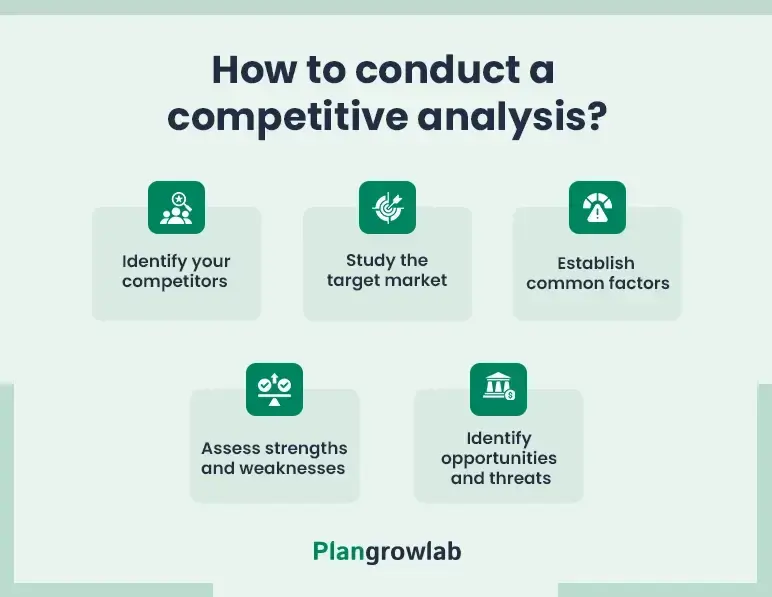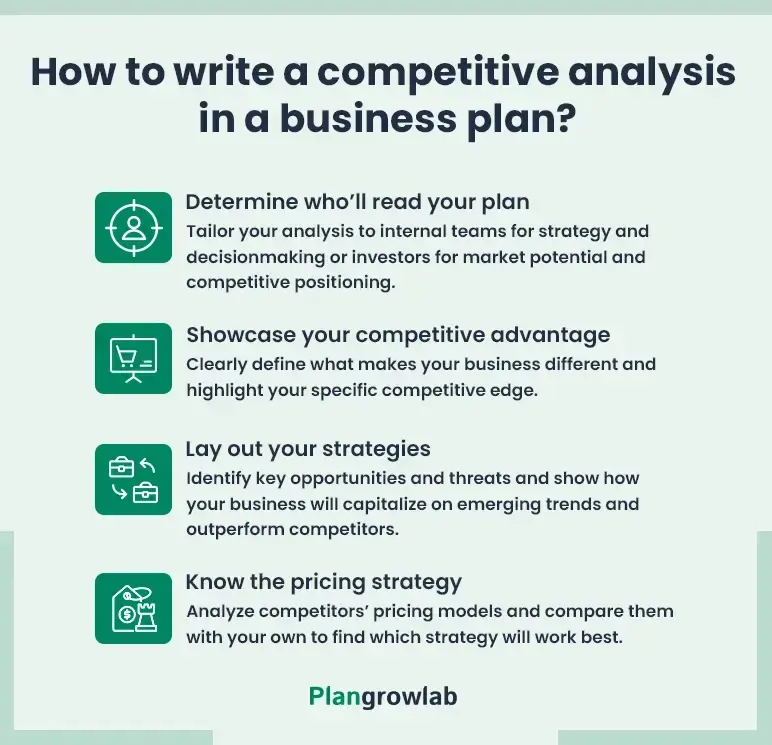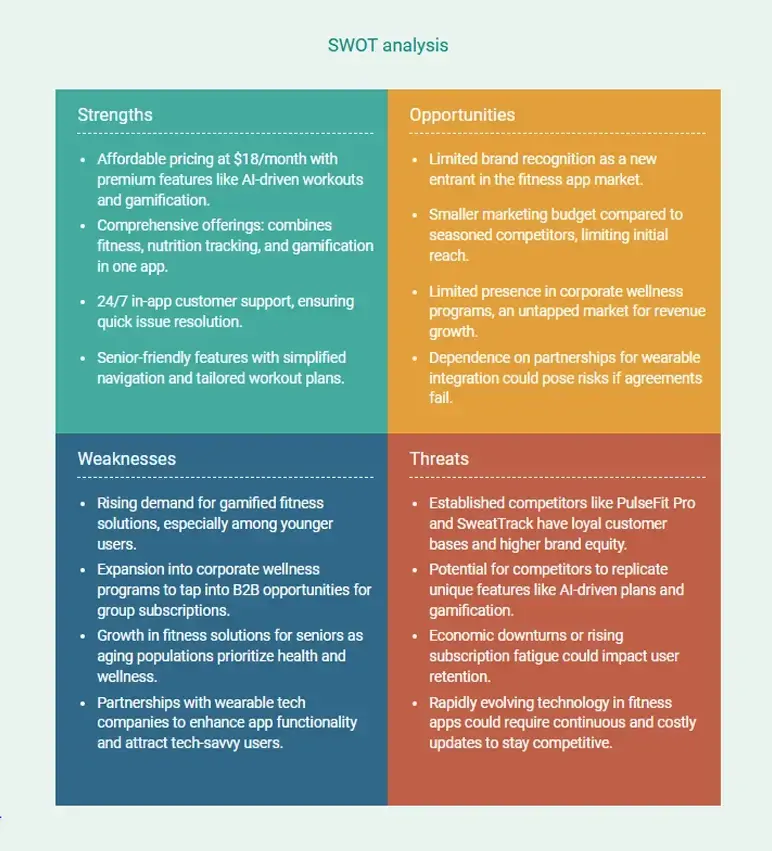What’s the one thing you and your competitors have in common?
You’re all fighting for the same customers—and possibly Googling each other at 2 AM.
While the ambition is good, the approach isn’t.
You need to understand what your competitors are doing, why they’re doing it, and how you can do it better—and competitor analysis is your only way out.
So in this article, we’ll tell you how to conduct a complete competitive analysis for your business plan from scratch. Let’s get started.
What is a competitive analysis in a business plan?
A competitive analysis involves gathering and analyzing all the required information about your competitors. The goal is to identify the competitors’ strengths, weaknesses, and business strategies in areas such as products, sales, and marketing.
Such an analysis helps businesses identify opportunities and develop strategies to improve their offerings. To sum it up, it gives you a competitive advantage by evaluating how your products compare to others in the industry.
Market analysis vs. competitive analysis
To understand the difference between market analysis and competitive analysis, we have prepared a table for you.
| Market analysis | Competitive analysis |
|---|---|
| Examines the overall market presence—including customers, trends, market size, etc. | Concentrates on identifying and studying the direct and indirect competitions. |
| Gives a broader view of the market. | Focuses only on the competitor’s strengths and weaknesses. |
| Identifies opportunities & challenges within the market. | Identifies competitive edge by understanding how competitors operate. |
| Gives insights into ideal customers’ needs, market potential, and trends. | Gives insights on competitive positioning, business strategies, and pricing strategy. |
| Guides market entry, product development, and marketing strategies. | Helps refine business strategies and improve competitive positioning. |
How to conduct a competitive analysis?
Follow these steps to understand how to conduct a competitive analysis for a business plan:

Identify your competitors
Create a list of direct (sell the same products/services) and indirect competitors (solve similar problems with different solutions). You can simply start with a Google search to see which businesses rank alongside yours or see on public forums what alternatives your ideal customers are going for.
Dan White is an SEO consultant who conducts competitor analysis for his clients. White says, “One of the big things I tend to focus on is who [my clients] share similar keywords with. It opens their eyes to understanding who they think their competitors are and who their competitors are, which are two very different things in Google.”
Study the target market
Understand the target market that you and your competitors share—you can look at demographics, purchasing behaviors, and needs and evaluate how your competitors meet customer expectations.
Establish common factors
Try to identify the common factors that you and your competitors share—such as distribution channels, products and services section, pricing models, marketing strategies, etc. as it helps you create benchmarks for comparison.
Assess strengths and weaknesses
Evaluate what your competitors are doing well and what they’re lacking to learn from their strategy and effectively position your company.
Identify opportunities and threats
Use the information you’ve gathered from market research to recognize the potential target market gaps your business can fill and the threats posed by your competitors.
How to write a competitive analysis in a business plan?

1. Determine who’ll read your plan
Depending on the audience who’ll read your plan, the information you offer in the competitive analysis report and its depth will vary. Generally, there are two types of audiences: internal teams and potential investors.
Internal purposes
If you’re doing a thorough competitor analysis for internal purposes—such as guiding your team or partners, the focus should be on providing actionable insights.
For example, if your team is working on a new fitness app, a detailed comparison of competitors’ features could help prioritize development efforts. The table might look something like this:
| Feature | Your Product | Competitor A | Competitor B |
|---|---|---|---|
| Personalized Workouts | Yes | Yes | Yes |
| Nutrition Tracking | Yes | No | Yes |
| Integration with Wearables | Yes | Yes | Limited |
| Gamification (Rewards) | Yes | Yes | Yes |
This table of the competitive analysis section can highlight where your app has a competitive edge such as gamification and better pricing, and where it might need improvement such as wearable integration.
If you’re a new business, you can also do a SWOT analysis here to assess your competitor’s strengths, weaknesses, opportunities, and threats for internal brainstorming.
External purposes
For external stakeholders like investors and banks, your approach should be persuasive—such as showcasing your market potential, growth trajectory, and competitive advantage in the particular market segment.
For instance, circling back to our fitness app example, here’s how you can highlight it:
| Competitors | Market Share | Key Features | Strengths | Weaknesses | Competitive Edge |
|---|---|---|---|---|---|
| Competitor A | 40% | High-quality workouts | Strong brand recognition, robust app UI | Expensive subscription, no rewards system | Affordable pricing, and gamification to drive user engagement |
| Competitor B | 35% | Wearable integration, tech focus | Advanced analytics, wearable compatibility | Limited workout variety, high churn rate | Comprehensive workout plans, and lower churn with the rewards system |
| Your Fitness App | 10% (Growing) | Gamification, affordable pricing | Unique rewards system, beginner-friendly | Limited current reach (short-term) | Differentiated by affordability, simplicity, and gamification |
This table provides potential investors with the information they need about your competitive landscape to understand your market dynamics and growth potential thoroughly.
You can also include a market growth chart alongside this table to highlight the increasing demand for fitness apps in general and the growing trend of gamification or rewards-based systems.
2. Showcase your competitive advantage
This section of competitive analysis involves highlighting your competitive advantage, i.e., what makes your own business stand out in your target market—such as innovation, pricing, or better customer service that will help you outperform your competitors.
For example, if you’re launching a fitness app, your competitive advantage might lie in personalized workout plans, seamless integration with wearables, and rewards-based gamification.
However, don’t limit your edge to your particular service and market segment. Instead, highlight every area you excel in—even tangible factors like brand reputation, operational efficiency, and more.
3. Lay out your strategies
Here, you can highlight opportunities or threats from market research—basically, show how your businesses respond to certain scenarios and overcome them.
Start by pointing out the opportunities and threats your business will have over your competitors and outline how your business will respond to them.
Let’s say your competitive framework of the fitness app shows scope for seniors as the younger target audience is already crowded—you can come up with features like larger fonts, simplified navigation, and exercises that focus on balance and joint health
Then move on to identify the potential threats that can come your way—and address how you plan to overcome them.
For example, if your competitors are lowering prices to get more customers, you can shift your focus to providing more value instead of getting into a price war.
Your goal here’s to communicate why your target customers should choose your business over others.
4. Know the pricing strategy
The pricing strategy of your competitors directly impacts your ability to position your business effectively.
That’s why, getting your pricing right starts with understanding what your competitors are charging and why. Look at their pricing models—are they using subscriptions, freemium plans, or one-time payments? Pay attention to what’s included at each price point and whether there are extra costs.
Comparing the features and value offered at different price levels helps you identify gaps in competitors’ offerings. Once you have a clear picture, compare it with your pricing to determine your competitive advantage.
Whether it’s offering more value at the same price or focusing on quality over cost, your pricing should highlight what makes your business the better choice.
For example, if competitors charge $30/month for a premium plan but lack gamified features, and your app offers them for $20/month, you’ve identified a pricing and value advantage. Let’s break it down in the table below:
| Features | Competitor A | Competitor B | Your App |
|---|---|---|---|
| AI-driven Personalization | Yes | No | Yes |
| Wearable Integration | Yes | Yes | Yes |
| Gamified Features | No | Yes | Yes |
| Nutrition Tracking | Yes | No | Yes |
| Pricing (Monthly) | $30 | $25 | $20 |
This comparison chart highlights where your fitness app excels compared to competitors.
Should you hire professionals for competitive analysis?
Absolutely! You can research yourself by googling your competitors, but professionals bring industry knowledge, analytical skills, and experience with different business models. They know what metrics matter, where to find hidden insights, and how to analyze the collected data.
In fact, they elevate your ENTIRE business plan because they can refine your strategy, strengthen financials, and ensure your plan makes sense to investors and lenders.
Moreover, whether you need the whole business plan done, a second opinion, or just some expert tweaks, a professional provides the flexibility to get you the help YOU need.
Bottom line? Hiring a pro isn’t about doing things the “right” way. It’s about making the process easier, faster, and more effective so you can focus on growing your business and always be ahead of your competitors.
Business plan competitive analysis example
Here’s a competitive analysis example for business plans to give you a better understanding.
Business Name: FitFlex Wellness App
Industry: Fitness and Wellness Technology
1. List of competitors
FitFlex Wellness app competes with both direct and indirect competitors in the fitness and wellness technology space. Below is an analysis of its competitors:
Competitor A: PulseFit Pro
PulseFit Pro is a premium fitness app targeting tech-savvy professionals. It has been a market leader for five years, with a strong focus on advanced technology and wearable integration.
Key features:
- AI-generated workout plans tailored to user preferences.
- Extensive integration with fitness trackers and smartwatches.
Weaknesses:
- Premium pricing limits accessibility for budget-conscious users.
- Slow email-only customer support leads to poor user satisfaction.
FitFlex advantage:
- Combines similar AI-powered personalization with an affordable subscription fee of $18/month.
- Offers 24/7 in-app chat support, ensuring faster issue resolution.
Competitor B: SweatTrack
SweatTrack focuses on gamified fitness, targeting young adults and casual fitness enthusiasts. It engages users with challenges and leaderboards.
Key features:
- Rewards-based gamification.
- Minimal integration of nutrition tracking.
- Subscription price of $20/month.
Weaknesses:
- Lacks comprehensive health metrics or wearable compatibility.
- Limited customization for advanced fitness goals.
FitFlex advantage:
- Combines gamification with nutrition tracking and advanced goal-setting features, appealing to a wider demographic.
- AI integration for dynamic goal adjustment, missing from SweatTrack.
Competitor C: ZenFit
ZenFit targets niche markets such as yoga enthusiasts and mindfulness practitioners, offering guided meditation and group yoga classes.
Key features:
- Live yoga sessions and mental wellness content.
- Affordable subscription at £15/month.
Weaknesses:
- Limited focus on physical fitness goals like strength or cardio.
- No gamification or AI-based personalization.
FitFlex advantage:
- Offers a holistic approach with a balance of physical fitness, gamification, and basic wellness tools.
- Includes strength, cardio, and flexibility-focused plans for a well-rounded experience.
2. Competitive pricing
FitFlex Wellness app is competitively priced to attract diverse user groups while offering premium features:
- FitFlex Subscription Fee: $18/month
Competitor Pricing Comparison:
- PulseFit Pro: $25/month
- SweatTrack: $20/month
- ZenFit: $15/month
Pricing Strategy: FitFlex positions itself as a mid-range option with premium features like gamification, AI customization, and wearable integration, offering superior value compared to competitors.
3. Payment options
FitFlex supports a variety of payment options to ensure flexibility for its users:
- Credit/debit cards
- Mobile payments (Apple Pay, Google Pay)
- PayPal and online transfers
- Annual subscription bundles at a discounted rate
4. Competitive advantage
FitFlex Wellness app differentiates itself from competitors through the following:
- AI-powered workouts: Dynamic plans tailored to individual progress, ensuring users stay motivated and achieve their goals.
- Comprehensive features: Combines gamification, nutrition tracking, and wearable integration in one platform.
- Affordable pricing: Delivers premium services at £18/month, striking a balance between value and cost.
- Customer support: Provides 24/7 in-app chat support, a stark contrast to competitors’ slower response times.
- Targeted segmentation: Includes features designed for seniors, such as simplified navigation and low-impact exercises, which most competitors overlook.
- Engagement: Uses rewards-based gamification to keep users engaged, increasing retention rates by 30% during beta testing.
5. SWOT analysis
This SWOT analysis highlights the FitFlex Wellness app's strengths and weaknesses, areas of improvement, and actionable opportunities.

What if I have very few direct competitors?
Very little direct competition can be both an opportunity and a challenge for an entrepreneur. While it suggests less immediate or primary competitors, it also raises concerns about market viability and scalability.
Here are some questions you should ask yourself in that case:
- Is there a real demand for your product or service? A lack of competition could mean a lack of market interest.
- Are there indirect competitors? Even if no one offers exactly what you do, alternative solutions may exist.
- What barriers to entry exist? If others haven’t entered the space, is it due to high costs, regulations, or other obstacles?
- How will you educate your market? If your offering is new or unfamiliar, customer awareness and trust-building will be crucial.
Fewer competitors can be an opportunity to establish a strong first-mover advantage, but it’s important to validate the market before diving in.
The bottom line
Now, we hope you know how to conduct and write a competitive analysis for your business plan without feeling unfamiliar with your direct and indirect competitors, their marketing strategies, and their possible moves.
However, if the whole process of writing a competitor analysis seems daunting, consider working with experienced consultants at Plangrowlab. We help uncover direct and indirect competitors’ hidden strengths and weaknesses, find relevant opportunities, and deliver a competitive edge that’s hard to beat.
In fact, we create complete business plans that include a complete competitive analysis report, marketing efforts you’ll need, financial projections, primary and secondary research needed to understand your business, and more!
Instead of spending hours lost in research rabbit holes, take a smarter approach to competitive analysis.
Frequently Asked Questions
Is SWOT a competitive analysis?
No, SWOT analysis isn’t a competitive analysis. However, it’s a method that helps you analyze competitors and evaluate a company's strengths and weaknesses, along with its potential opportunities and threats in the target market landscape.
What to include in a competitive analysis?
Competitive analysis includes:
- Direct competitors
- Indirect competitors
- Market overview
- Competitor profiles
- Competitor strengths and weaknesses
- Market positioning
- Marketing and sales strategies
- Performance metrics
- Opportunities and threats
- Competitive gaps
- Summary and action plan
Is hiring professionals for competitive analysis worth it?
Yes, hiring professionals saves time and ensures accurate competitive analysis, leveraging their expertise and specialized tools to deliver deeper, strategic insights that drive actionable decisions for your business.
Which tools are best for competitive analysis?
SEMrush, Google Trends, and Ahrefs are great tools to understand your competitive landscape as they help you collect adequate competitor data and assess their performance.

